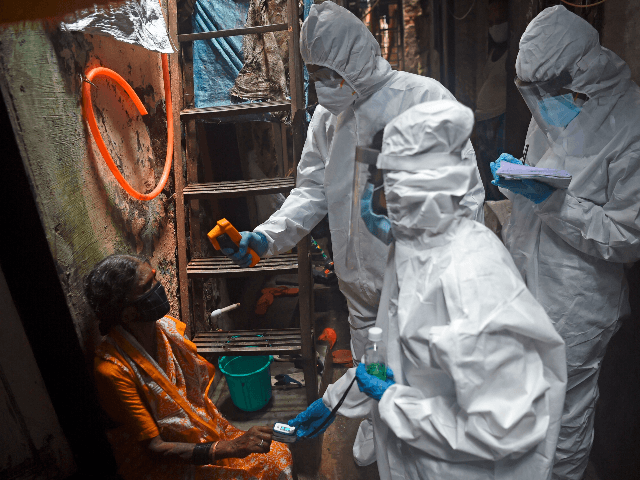A study commissioned by the city of Mumbai revealed on Tuesday that over half of the people living in its famously crowded slums have antibodies for the Wuhan coronavirus in their blood.
As with seemingly all other news about the virus, both supporters and critics of the Indian government claimed the data vindicates their position.
WION News reported the results of the study accompanied by an observation that infections appear far more prevalent in Mumbai than expected, but “deaths in the sprawling slums have not exploded,” so city officials took the data as evidence their approach to the pandemic was correct:
India is already the third worst-hit country after the US and Brazil, with nearly 1.5 million cases though experts have previously said the lack of testing could mean the true tally is much higher.
Blood tests on 6,936 randomly selected people conducted by Mumbai’s city authorities found that 57 percent of slum-dwellers and 16 percent of non-slum residents had virus antibodies.
Mumbai, where about 40 percent of the population lives in slums, has reported just over 110,000 infections and more than 6,000 deaths so far.
A survey performed in May found 30 to 40 percent of Mumbai’s slum residents had coronavirus antibodies, so the 57 percent figure provided by the new study represents a substantial increase that approaches the much-discussed “herd immunity” threshold.
Another study found 23 percent of the comparably populous Indian capital of New Delhi have developed coronavirus antibodies, a figure also considered surprisingly high by researchers compared to hospitalizations and fatalities in the city.
“There is some comfort in this evidence of widespread asymptomatic transmission, which exceeds detected cases significantly, because the big takeaway is that a lot of people getting Covid in India are none the worse off for it,” the Times of India (TOI) editorialized on Wednesday.
TOI chastised “non-cooperative” residents from outside the slums of big cities for making it difficult to compile accurate infection and antibody data.
“This is unconscionable,” TOI declared. “Overcoming this virus depends on significantly increasing our body of knowledge about it.”
Jayaprakash Muliyil, head of an advisory committee at the Indian National Institute of Epidemiology, greeted the new study as evidence the slums “may have reached herd immunity” and suggested that if “people in Mumbai want a safe place to avoid infection, they should probably go there.”
Muliyil credited containment measures with reducing the number of deaths from the coronavirus, but appeared dubious that any quarantine regimen could truly prevent the disease from spreading in crowded areas.
“The virus does its work. The virus doesn’t worry about your quarantine and it is much more efficient than your efforts to contain it,” he said.
Herd immunity is an elusive concept that suggests a disease will die out once a sufficiently high percentage of the population has been exposed to it and developed antibodies. The exact level of exposure necessary to develop herd immunity is difficult to determine and is different for various diseases, but it is generally thought that 50 to 80 percent of a given population must become infected. Some virologists fear the Wuhan coronavirus could be one of the diseases for which herd immunity is never developed naturally.
Time is another vital aspect of herd immunity. The theory holds that an infection must spread fairly quickly for the population to develop antibodies against the current strain and choke the virus into submission. This is why some epidemiologists are critical of mitigation strategies that cause a virus to spread slowly and inexorably.
India’s data could help develop an understanding of whether herd immunity is a concept applicable to the Wuhan coronavirus, and if rapid spreading through the densely-populated slums proves to be more, or less, dangerous in the long run than a slow, contained spread through the upper-class regions of Mumbai and New Delhi.
As CNN pointed out, India has a fairly low coronavirus mortality rate overall despite a large number of reported infections and poor sanitation in the packed slums, where “residents live cheek-by-jowl in tiny homes with no running water, and share toilet facilities with several other families.” The slums of Mumbai currently feature 627 active virus containment zones.
Prime Minister Narendra Modi regards India’s high recovery rate and aggressive testing regime as signs of success and may begin relaxing pandemic restrictions in the next few days.

COMMENTS
Please let us know if you're having issues with commenting.